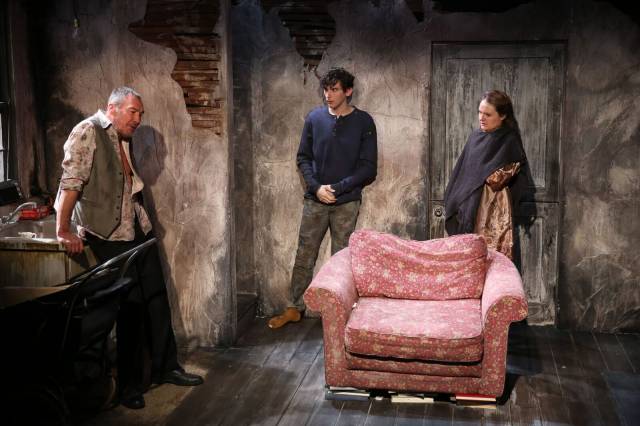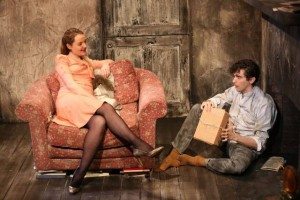

In 2016’s 1st Irish Festival, Nancy Manocherian’s The Cell raised the splintering roof with Honor Molloy’s Crackskull Row, a one-act play soaked to the bone with rough and tumble memories that will not rest. Crackskull's Moorigan family may be fractured and careless, but they are tight nonetheless as well as bare-knuckle protective. Here, playwright Honor Molloy discusses the play, its Dublin origins and its current run at the Irish Repertory Theatre.
Crackskull Row plays with memories that manifest quite literally, willfully continuing in the malformed shapes of kin. Your novel Smarty Girl and the earlier time setting of this play coincide with your own Dublin childhood. How does the potency of your childhood memories interplay with the drama of your work?
In the 1950s and 60s, my mother and father worked together in Dublin theaters - from Madame Cogley’s Pocket Theatre to The Pike, to The Gaiety, to The Gate. I was in and out of those theaters since I could walk – backstage, in the dressing rooms, waggling my shoes while waiting in the velvet seats for the play to begin. Actors and producers, writers and musicians dropped by our house when they were in the neighborhood. There was no separation between theatre and life. My big sister Shivaun told me stories – many of them Irish myths. So when I come up with the notion for a new play that’s set in Ireland – immediately there are ghosts, and mystery, and shifting theatrical worlds.
The arrangement of your writing is well-balanced, rhythmically and mathematically, the time signature of dialogue and the time frame of 1966 and 1999 - mid-century to the tail-end with numbers in reverse; in addition, the narrative within the two time periods of this one family. Is the symmetry of the play instinctive or calculated?
It’s really just the way history gave it to me – with the numbers. Nelson got blammed back to England in the third month of 1966. And my father and big sister died in 1999 – the da in September, the ninth month and Shivaun in December. That’s a twelve – one plus two equals three, do yeh see? Their deaths propelled the writing of the play. And, I believe, their ghosts gave me the more magical bits of the story.
I’m fascinated with the number three and the eternal redundancy of the number nine. A number of the play’s most elevated lines scan in nine syllables. “Old pater hairy-arse, Lord Nelson.”
As far as language helping to differentiate each time period – it’s listening. Paying attention. And research. It’s reading victim accounts of institutional abuse in Ireland and in America. It’s picking through newspapers. There’s nothing like the specificity of ads from 1966 – “Small World, Big Airline. PanAm Makes the Going Great!”
 The peeling nooks and crannies of Crackskull Row's converted stable home are essential to the plot. You yourself spent the early part of your childhood in a stable-cum-mews home, also in Dublin. How much of a character is the Moorigan home and how did you conceive of it as so?
The peeling nooks and crannies of Crackskull Row's converted stable home are essential to the plot. You yourself spent the early part of your childhood in a stable-cum-mews home, also in Dublin. How much of a character is the Moorigan home and how did you conceive of it as so?
In the late 1950s, my father converted a stable behind the Georgians lining Ely Place. We had one downstairs room and two tiny upstairs bedrooms for my tall parents and six kids. There was a fireplace built of sparkling Wicklow granite. I often cleaned that fireplace – scrubbed the hearth, pretending I was Cinderella. I’d look up through the chimney passage to the sky above. Anything can happen in a fireplace.
The set is indeed a character indicating that the matriarch Masher Moorigan is stuck in the past that’s decaying around her. The animal-pen nature of her home is intentional and the fireplace we constructed continually amazes and delights the audience. There are times when the house comes alive. It’s as if it’s taunting Masher and will eventually devour her.
How did you come to be involved with The Cell and director Kira Simring?
Ah, the majesty of Nancy Manocherian’s the cell. In early October of 2014 I presented a brief scene from a play of mine. Artistic Director Kira Simring was in the audience and asked if I had a play for her. I sent her Crackskull the following day – which she read immediately. Within a week four Irish actors gathered in her apartment for a cold read. By the end of that session Kira had committed to the cell presenting an Equity Approved Workshop. This fast-tracking of a play NEVER HAPPENS.
How have Kira and the cast altered the shape of the play from its origins on the page?
A play isn’t finished until the actors, director, designers, producing and marketing teams make their contributions. And then the audience takes in the play and responds.
My scripts have minimal stage directions. I wait until rehearsal to uncover the play’s physical world. The entire Crackskull team kept learning about the characters in how they moved about the space and what they needed from their physical world so they could clearly tell our story. We learned that there are meanings under the meanings of words, symbols, gestures. Kira actually excavated the script – plumbed the depths of its language by bringing it into the rehearsal room and moving it around inside the Moorigans’ home. As a result, I kept honing the script and tightening it to the point that not one unnecessary syllable remains.

Because The Rep’s M. Scott McLucas Studio Theatre is thirty percent smaller than The Workshop – the actors had to modulate their voices and their physicality. They had to tone down their performances and turn their intentions in. Because we had the good fortune of receiving a new production with two-weeks rehearsal and a six-week run, the actors had ample time to enrich their understanding of their characters.
We also learned what the set needed to do in terms of magickry – so this time round there are surprises galore.
As the playwright, how much of the rehearsals and performances do you sit in on? Is there a cut-off point or do new discoveries continue to crop up?
I don’t like to sit in on rehearsals. I want the actors and director to have total freedom. Also, much of this material is intensely personal, so I don’t want to watch it happening over and over.
With both Crackskull incarnations, I went to rehearsals once or twice a week. I attended each preview and much of opening week. After that – the child is in college, so I pop by once weekly through the run.
This time round, I was making small changes to the script into preview week. But now our show has become its own little animal – a beast.
You were raised in Ireland and America but your voice hails from the Old Country. The Irish have a knack for looking darkness head on and laughing at the murk. Your play is savage at times in its dealings with violence and taboo liaisons, yet it never loses its comic edge. Can you tell me about the part humor plays in Crackskull Row?
My father was a comedian - a seventh generation Dubliner who shouldn’t have survived his teen years. He was playful and funny, charming and seductive and. He was also a brute. This is why I left my country at the age of eight. I lost my accent in a handful of days. But Dublin never left me. When I started writing theatre pieces in 1985 – they were about him. And they were funny and brutal and brutally funny.
In terms of my American plays – usually there’s one Irish character in there setting the world to right. But I do like dreaming up a USDA Grade-A American playworld.

The dark frame between the two worlds is the 33 years Young Rash spends in jail and what happens to him while locked inside the sinstitutions of Ireland. I didn’t know this was such an important component of the play until Kira asked for a timeline of the action. And I realized there was a gap there that I had to fill in. So, I read about Ireland’s confinement of their poor in the 50 years after partition in Eoin O’Sullivan and Ian O’Donnell’s Coercive Confinement in Ireland. I studied the transcripts of clerical abuse in the Altoona-Johnstown Diocese. And I read up on Bill Cosby – “I was not stopped,” Masher Moorigan says.
You returned recently to Dublin and to the Rotunda, the hospital where you were born. Can you tell me a little about the project you're working on?
Aedin Moloney and Fallen Angel Theatre Company will be producing Maiden Voyages (written with Bronagh Murphy) in their 2018 season. It’s set in the Rotunda – the oldest maternity hospital in the world. So, I went home in December to start in on the research. It seems that everyone I bumped into in cafes and pubs had secrets to share and stories of ghosts. Kira Simring will direct a cast of six women – at night on the ward.